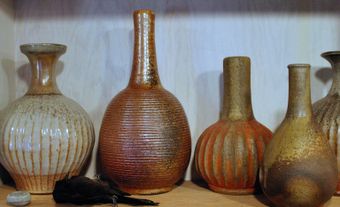The Gardiner Museum of Ceramic Art is located in downtown Toronto. It was designed by Bruce Kuwabara and his team at KPMB Architects. Approaching the museum, one encounters an elevated cube cantilevered towards Queen’s Park. Its fritted-glass windows are set back from the building’s elegant limestone facade. The building is a dramatic extension of the modest original. The original building was a stately, two-storey neoclassical modernist structure designed by Keith Wagland. (He was one of Kuwabara’s professors at the University of Toronto.) It was completed in 1984.
By the time Bruce Kuwabara was commissioned to redesign the Gardiner, he was very familiar with the museum and its collection. During the 1990s, he designed the installation for a series of art exhibitions at the Casa Italiana in Toronto. There he met a wide variety of artists and curators, including those who worked with the Gardiner. In 2000, the Gardiner asked Kuwabara to design and install what turned out to be one of their landmark shows: Miró: Playing with Fire. It was an exhibition of Spanish artist Joan Miró’s works in ceramics.
“I ended up doing the whole exhibition myself,” said Kuwabara. “I bought really nice earth-colored silk to back some of the displays and had copper plumbing pipe specially cut to hold works and set them at various angles so that you could see past all of them. I had a single light directed at each piece in the show. And in the process of doing all this, I learned a great deal about the problems with the original building — the columns, the loading docks, the fact that simply moving around the building was difficult.”

Kuwabara’s work on Playing with Fire was very successful. Miro’s grandson thought it was the best installation of Miro’s work he had ever seen. The show led directly to a commission to redesign the museum.
“By the 2000s, Toronto’s cultural renaissance was in full swing,” said Kuwabara, who has had a major impact on Toronto’s cultural landscape. He was also the chief architect for Canada’s National Ballet School, the TELUS Centre for Performance and Learning at the Royal Conservatory of Music, and the TIFF Bell Lightbox.
“My main issue to begin with was orientation,” Kuwabara said. “The original building was actually designed for an additional floor, so I did sketches with double elevations, building up. But one of my principal priorities was also to respect the adjacent properties, which in this case includes the Royal Ontario Museum, the Lillian Massey Building, and Annesley Hall. For me, a contemporary building should assert its identity while respecting the buildings around it — in a way, that is a good definition of what is best in contemporary Canadian architecture.”
Kuwabara’s Gardiner Museum is incredibly elegant. The beautiful, textured Indiana limestone, subtly luminous in full daylight, as well as the clean, vertical lines of the windows, mirrors the beautiful collection of ceramics acquired by George and Helen Gardiner. The collection includes pre-Columbian earthenware, 15th-century Italian Majolica, and 17th-century Chinese and Japanese porcelain. There are also sumptuous porcelain plates, bowls and cups from 18th century Germany, France, and England.
Today’s Gardiner Museum is very much part of Toronto’s dynamic urban landscape. In that respect, its third-floor terrace is its heart. “The third floor, where Jamie Kennedy’s restaurant is located, is really all about our affairs of the moment — from the terrace you look out on the Park Hyatt,” said Kuwabara. “And the terrace itself is a contemplative place, allows for a contemplative moment, where you can arrive at a deeper consciousness of the city.”
See also Ceramics; Contemporary Ceramics; Decorative Arts in Canada.

 Share on Facebook
Share on Facebook Share on X
Share on X Share by Email
Share by Email Share on Google Classroom
Share on Google Classroom














